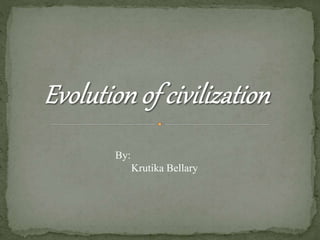
Evolution of civilization
- 4. The oldest human footprints in the world were unearthed at Laetoli, near Olduvai Gorge, in Tanzinia. These footprints led Owen Lovejoy to conclude that even these early hominids
- 5. Lucy - is one of the oldest and most complete skeletons of human ancestry, which was discovered by Don Johansson in Ethiopia's Afar Triangle.
- 6. Ramapithecus - ape man Australopithecus - definition of a man Homo erectus or Homo Sapiens - true man Heidelberg man - primitive man Neanderthal man - skill full hunting Cro-Magnon man – extinct mordern man lived in caves they were hunters and gatheres
- 9. The pre-historic period was divided into – 1. Paleolithic age 2. Neolithic age 3. Chalcolithic age
- 10. Paleo - Old ; Lithos - Stone Paleolithic or Old Stone Age dates from the first stone tool makers (approx. 2 million BC) to about 10,000 BC. They used the rough/rugged stones for tools and weapons. Absolute dependence on nature by gathering food and hunting animals.
- 11. Discovered fire from stones for cooking, warmth and protection from animals. Extremely nomadic way of life (moving from place to place to hunt). Developed simple tools from stone, bone or wood. Invented clothing. Cave paintings and religious rituals.
- 13. Neo – New ; Lithos - Stone This period began in Ireland with the arrival of the first farmers around 3500 BC. Organized farming methods and crops and animals. New house types. New crafts . Burials rituals – megalithic (great stones). They used polished and bladed stones. More sedentary life (stayed in fixed places able to build cities).
- 14. Farming became a major part of humans in the Neolithic age
- 18. Also known as the “ Copper Age” began at around 4500BC This age was the age of metals. The discovery of which was a milestone in the growth of civilization The use of copper was at large, but later it was also mixed other metals that were discovers during that time which resulted in the discovery of bronze. Indus Valley Civilization is the best example in the civilization of copper age. The metal was mainly used to make axes, swords, spearheads, etc. used for hunting and farming.
- 22. Indus civilization is also called Indus valley civilization or Harappa civilization. It was not discovered until the 1920’s. These settlements were established along the Indus River some 5000 years ago. These were one of the world's earliest major urban settlements. The Indus civilization is known to have comprised two large cities, Harappa and Mohenjo-Daro, and more than 100 towns and villages, often of relatively small size but well planned and walled. Trade and Agriculture were the major sources of their income. Harappa to have been far larger than once thought, perhaps supporting a population of 50,000 at certain periods
- 23. These cities were well planned with wide streets, public and private wells, drains, bathing platforms and reservoirs. One of its most well-known structures is the Great Bath of Mohenjo Daro .
- 24. People in the Indus Valley played board games like this, moving pieces between squares. Maze puzzles and dice games were enjoyed by children and adults.
- 27. The period of new civilization is divided into three phases – Ancient Age Medieval Age Modern Age
- 28. The growth of kingdoms, steel weapons, writings, politics, military, money, etc. were the foundations of the new civilization. Literacy rate was on the rise with the expansion of Rome. Roman empire showed how governing could help the new civilization.
- 29. In India, Indus Valley Civilization marks the beginning of the ancient civilization. In early vedic period, the social order in ancient India enabled members to smoothly climb the ladder of life. The religion of the Indian origin was very simple and its contributions are evidently high. The four stages in an individuals life were - Bhramacharya - Grihastha - Vanaprastha and - Sanyasa.
- 30. There was also division of classes called “ Varnashrama Dharma”. The classes were - Brahmin: the one who parts knowledge. - Kshatriyas: the ones defending the society. - Vaisyas: were farmers. - Sudras: the traders • This social order did not imply any discrimination such as big or small, high or low in its constituents.
- 31. The complete life concept called “Chaturvida Purushartha” marked out the Indian society globally. These fourfold objectives of life are- - Dharma: the universal law - Artha: the wealth - Kama: the desire - Moksha: the salvation
- 32. • The later vedic period saw the formation of powerful kingdoms like panchala, kosala, maghada, etc. • During this period, mauryas and guptas in the north; satavahans, pallavas and cholas in the south of India realized the importance education and established universities like Nalanda, Ujjain, Sarnatha, Ajantha and Taxasila. • Great scientists like Aryabhatta, Virahamihira, Brahmaguptha and others flourished during this period. • Establishments like institutions, health-care centers, trade links, etc. were major achievements seen in the ancient age.
- 33. It starts with the fall of the Roman Empire and establishment of the Muslim rule in India. India was under the Muslim rule for over 600years. Hinduism and Islam were however in the opposed and influenced movements like Sufi among Muslims and Bhakti among the Hindus. The unity of these two civilizations developed art called “The Indo-Muslim Art”. Taj Mahal, Qutub Minar, Red Fort, etc. are the examples of such art. The medieval age formulated and reformulated the socio- economic order to meet the challenges of the changing times.
- 35. Scientific inventions and technological revolution is evident in the modern historic period. Invention of microscope and telescope led to the discovery of other many things. Advancement in the field of agriculture industry and communication was a major support for the progress of the civilization.
- 36. Science and civilization textbook- Madan Lal Malpani V.Prabhakaraiah Saraswati Rao Acadamics.triton.edu.com